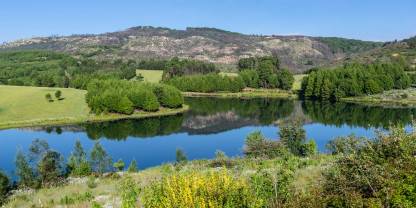Average Expert Rating
Rating Breakdown
Write a User ReviewWooded Hills and Waterfalls
If you believe a safari just isn’t a safari if it doesn’t include a few Big Five encounters, Nyanga is unlikely to make your shortlist. To me, this park’s biggest appeal lies in its hiking potential. Naturally, hikers would argue that a shortage of large, dangerous animals is a distinct advantage in making lengthy walks both feasible and enjoyable. The region is so tame that, in the 1890s, Cecil Rhodes snapped up a large chunk of it for orchards and grazing.
While you’re unlikely to see big cats in Nyanga, this large, mountainous park in Zimbabwe’s Eastern Highlands is by no means devoid of wildlife – you’ll see antelopes and birds as you tackle the trails.
I love the variety of scenery here – there are some stunning panoramic views from the higher ground, and some tremendous rivers and waterfalls in the valleys.
A Short Scenic Drive Through the Eastern Highlands, and a View of Zimbabwe’s Tallest Waterfall
This is an easy park to visit and there were good views of the Nyanga Mountains from the main ‘circular’ gravel road. On the higher slopes was moorland vegetation and in the valleys, dry grassy plains, but I only saw a couple of grazing antelope. The highlight was the viewpoint overlooking the Mutarazi Falls (762 metres), a free-leaping waterfall of two delicate tiers and the tallest waterfall in Zimbabwe. Beyond was the Honde Valley, some 800 metres below, with its lovely bright-green tea estates and wooded areas of wild fig trees. Combined with a stop for tea at one of the country hotels near the park, it was a pleasant country drive, but I find the scenery in the Vumba and Chimanimani mountains south of Mutare more dramatic.
Walking Trails & Log Fires
Nyanga National Park lies in the north of the scenic Eastern Highlands, Zimbabwe’s most popular walking destination. Although often described as a stunning part of the country, the park is far from pristine. Most of the indigenous vegetation has been cleared for farming and forestry, and many mountain slopes are covered in exotic pine and wattle. There isn’t much wildlife around, but you might see reedbuck on the grassy slopes and maybe samango monkeys and blue duiker in the indigenous forest patches.
For me, the highlands offer a great escape from the sweltering heat and humidity of the Zambezi Valley. The rolling green hills, high waterfalls, mountain peaks and perennial streams create a lovely setting for long country walks and evenings spent by a log fire.
Rhodes’s Former Estate in the Eastern Highlands
The centrepiece of the highlands to the north of Mutare, Nyanga National Park, was at one time the personal property of Rhodes. The boulder-strewn moonscapes, dominated by immense onion-peel granite domes that dwarf their more publicised relatives in Matobo National Park, are inherently very beautiful – and unmistakably Zimbabwean. But Nyanga is also the most ecologically compromised of Zimbabwe’s major parks, with much of the natural cover of heath and indigenous woodland now replaced by timber plantations and fruit cultivation. Several wonderful sites lie close the park, notably the Bvumba and Chirinda Forest Reserve, which protects several very rare bird species in what is Africa’s most southerly true rainforest, and the wonderful waterfalls and highland meadows of the Chimanimani Mountains.
Scotland in Africa
This is a great park to come to after a lengthy safari in hot, dusty, open game-viewing vehicles when you’re dying for some cool mountain air, but don’t come for big game viewing because there isn’t any. Golf, trout fishing and hiking will keep you busy. The scenery’s lovely (if you can ignore the forestry plantations) and there are some great places of historic interest, but it’s not a safari destination. Having said all that, if you’re a keen birder this, along with other places a little further south in the Eastern Highlands (notably the Bvumba area), is truly one of the continent’s hot spots. You’ll need a specialist guide to locate your wish-list birds deep in the indigenous woods and forests (also home to the charming Samango monkey), and needless to say the best birding is during the wet, summer season, but you certainly won’t go home disappointed.

